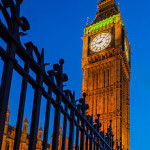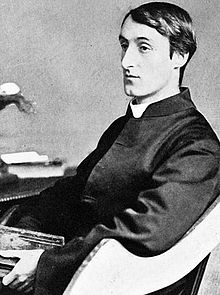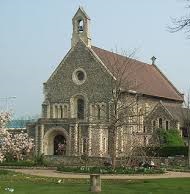Our wonderful friend and author, Stuart Miller-Osborne has really done us proud with this article on Pugin. I can relate to this article very much as St James Church also had a school (St James School) where my eldest brother attended until they built the new Hugh Faringdon Catholic School, Bath Road, Reading, where myself, two brothers and two sisters were taught. My youngest brother went to a Church of England School, but we were all brought up in the Catholic faith. My parents were married in the English Martyrs Church in Tilehurst, Reading just after WWII. Excuse my ramblings, but the the Church, the Abbey Ruins and the beautiful Forbury Gardens were a big part of our lives when growing up and Stuart’s article brought back a lot of wonderful memories to me.
Augustus Welby Northmore Pugin is one of four Victorian heroes I have. The others are Richard Burton, Gerard Manley Hopkins and obviously Brunel. Whilst Brunel is very well known the others sadly have faded a little into history. But for the moment I will concentrate on Augustus Pugin who in my view, was God’s Chosen Architect, borrowing from the title of his recent biography. He was one of those people that the Victorian era seemed to throw up frequently. He was not just an architect but a designer an artist and a critic and saved lives at sea in his spare time (He lived in Ramsgate).

Hungerford Arcade Big Ben London
When you think of the Gothic Revival, you think of Pugin. Thousands of people pass the Palace of Westminster each day but how many people know that Pugin was heavily involved in the rebuilding of this seat of government after the destructive fire of October 1834. The chief architect, Sir Charles Barry employed Pugin at the time. We have all seen Big Ben when visiting London, which was Pugin’s last major deign before his slow decent into madness. Incidentally, although we call the clock tower Big Ben, this is just a nickname and the tower has been known by a variety of names over the years including, The Clock Tower, St Stephen’s Tower and now The Elizabeth Tower.
 Although the Palace of Westminster is very much a secular building, my interest in Pugin comes mainly from the many churches he designed. Pugin came from an Anglican background and as a child was taken by his mother to Irving’s Scottish Presbyterian services which he found dull and sterile. His father Auguste-Charles Pugin who had fled from France during the French Revolution, is likely to have adopted the Anglican Church as his faith in order to receive commissions and I can see his logic for doing so. One has to remember that Non-Anglicans were barred from a large number of activities (Such as standing as an MP or being able to serve as a policeman to name but two of these activities). Although some of these restrictions were somewhat diluted by the Roman Catholic Relief Act of 1829 it still paid to be pragmatic which made Pugin’s conversion to Roman Catholicism in 1834 all the more suprising. But this was Pugin all over, he was a visionary and a man of set ideas. He had been heavily influenced by the ideas of The Oxford Movement which in short, was the then given philosophy of the High Church members of the Church of England.
Although the Palace of Westminster is very much a secular building, my interest in Pugin comes mainly from the many churches he designed. Pugin came from an Anglican background and as a child was taken by his mother to Irving’s Scottish Presbyterian services which he found dull and sterile. His father Auguste-Charles Pugin who had fled from France during the French Revolution, is likely to have adopted the Anglican Church as his faith in order to receive commissions and I can see his logic for doing so. One has to remember that Non-Anglicans were barred from a large number of activities (Such as standing as an MP or being able to serve as a policeman to name but two of these activities). Although some of these restrictions were somewhat diluted by the Roman Catholic Relief Act of 1829 it still paid to be pragmatic which made Pugin’s conversion to Roman Catholicism in 1834 all the more suprising. But this was Pugin all over, he was a visionary and a man of set ideas. He had been heavily influenced by the ideas of The Oxford Movement which in short, was the then given philosophy of the High Church members of the Church of England.
This subsequently developed into a form of Anglo-Catholicism and the movement which was mainly developed within the University of Oxford, looked towards the reinstatement of certain older Christian traditions and their inclusion into the Anglican liturgy and into its theology. As you can imagine, this was not that popular with the traditional church but slowly its ideas of The Oxford Movement were incorporated into the church (which you can still see to this day). There was more symbolism, more emphasis on ritualism and this was what influenced many at the time.
 Like Pugin, another one of my Victorian hero’s Gerard Manley Hopkins was heavily influenced by The Oxford Movement and produced some of the most astonishing poetry ever written during his short and tragic life. Pugin like Hopkins, was a man born outside of his time and sadly, both men were dead well before their fiftieth birthdays. Hopkins was forty-four when he died and Pugin was only forty.
Like Pugin, another one of my Victorian hero’s Gerard Manley Hopkins was heavily influenced by The Oxford Movement and produced some of the most astonishing poetry ever written during his short and tragic life. Pugin like Hopkins, was a man born outside of his time and sadly, both men were dead well before their fiftieth birthdays. Hopkins was forty-four when he died and Pugin was only forty.
Although not a Catholic myself, I deeply admire the religion and current Pope, who I consider has brought a breath of fresh air to the church. But what of the lost church of the title? Where is this lost church?
Well it is not really lost as like Big Ben, thousands pass it each day in cars and on foot. It is the St James Church in Reading, which is right next to the Forbury Gardens and can quite easily be seen from the railway and the prison. The church itself can be found near the ruins of the pre-reformation Reading Abbey which was dissolved by Henry the Eighth in 1539.
As most people are aware, certain parts of the abbey still exist but these ruins are slightly hidden in the urban sprawl of Reading. St James Church itself, still stands proudly alongside a very busy road and nearly opposite one of those dreadful modern retail parks. The church was built between 1837 and 1840, the land being the gift of a prominent local Catholic named James Wheble.
.
 The foundation stone was laid on the 14th of December 1837 and the church was formally opened on the 5th of August 1840 by Bishop Thomas Griffiths. But its main claim to fame was that St James Church, Reading was one of the earliest works of Augustus Pugin. It was built in a Norman Romanesque style, although there have been a number of alterations since (most notably in 1926 and 1962). The church was further altered in the 1970s in line the wishes of the Second Vatican Council but this does not detract from Pugin’s vision at all.
The foundation stone was laid on the 14th of December 1837 and the church was formally opened on the 5th of August 1840 by Bishop Thomas Griffiths. But its main claim to fame was that St James Church, Reading was one of the earliest works of Augustus Pugin. It was built in a Norman Romanesque style, although there have been a number of alterations since (most notably in 1926 and 1962). The church was further altered in the 1970s in line the wishes of the Second Vatican Council but this does not detract from Pugin’s vision at all.
 My wife and I visited the church recently on one of those magnificent autumn days where the light is so sharp and high in the sky that the seasonal trees almost seem to glow with colour. This provided a beautiful stage for Pugin’s lost church. I had expected to find St James locked but found the doors open and welcoming. Inside the church was almost silent, an oasis of peace contrasting greatly with the noise outside.
My wife and I visited the church recently on one of those magnificent autumn days where the light is so sharp and high in the sky that the seasonal trees almost seem to glow with colour. This provided a beautiful stage for Pugin’s lost church. I had expected to find St James locked but found the doors open and welcoming. Inside the church was almost silent, an oasis of peace contrasting greatly with the noise outside.
Although modernised there was much to see.
The baptismal font. I found out, had been built from the capital of one of the Abbey’s original pillars which were excavated at the time of the construction of the church. Caron and I spent nearly an hour in the church looking for Pugin and we met him quite often, which was an incredible experience. But I am not going to spoil it for you. If you do choose to visit St James, then it is your own experience not mine. Perhaps you have come from afar and are on your way to Hungerford and as Reading is the Clapham Junction of Berkshire, you might have decided to take tea. Killing time between trains. If so, do try to visit St James as it is well worth half an hour or more. You do not have to be a friend of Pugin to appreciate the church. It is just a lovely building.
This said, Reading is full of great churches and I have highlighted just the one that I feel I have an affinity with. I have visited some other churches in Reading and equally recommend them. There are many other churches designed by Augustus Pugin (Both Anglican and Catholic) as well as many other secular buildings designed by the great man. If you are interested, do look them up on the internet as there is a lot to see.
There are also a great number of churches which were not designed by Augustus Pugin which also reflect the values of The Oxford Movement. Most notably the church of All Saints,Margaret Street in London, which is just off of Oxford Street and well worth visiting.
Enjoy your travels I trust this short guide will have helped you.
Stuart Miller-Osbourne
Coming Soon – Forbury Gardens (Reading’s Hidden Gem)

